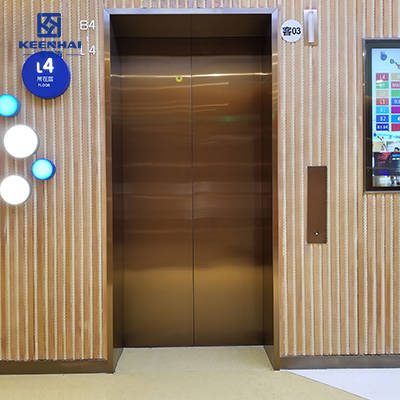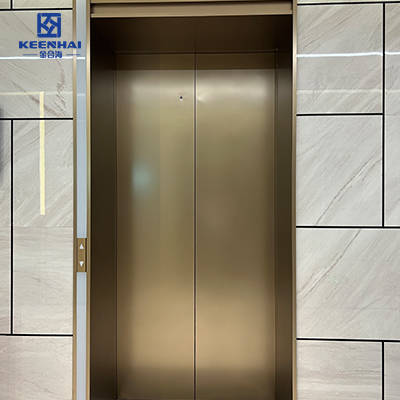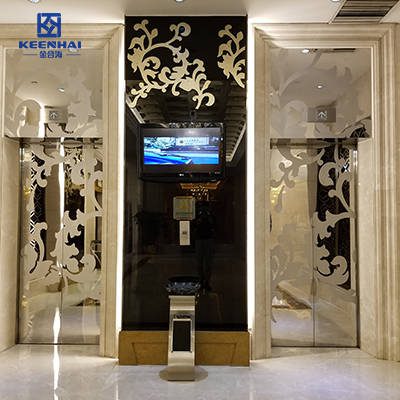Choosing between PVD and brushed elevator door finishes depends on traffic, aesthetics, and maintenance. PVD coatings provide high durability, vibrant metallic colors, and long-lasting wear resistance, making them ideal for luxury hotels and high-use commercial spaces. Brushed stainless steel is practical, low-maintenance, and blends with most interiors, offering subtle elegance in residential or moderate-traffic settings.
1. Overview of PVD and Brushed Finishes
Choosing between PVD and brushed elevator door finishes isn’t just about looks—it determines durability, maintenance, and the overall impression of the building. Selecting the right finish impacts how the doors perform in high-traffic areas, how easy they are to clean, and how well they complement interior design elements.
1.1 What is PVD (Physical Vapor Deposition) Coating
PVD, or Physical Vapor Deposition, is a process that deposits a thin, hard layer of metal onto the surface of stainless steel. This method creates a durable, corrosion-resistant, and visually striking finish that can range from gold and bronze to black or custom metallic tones. PVD finishes are especially popular for high-end commercial lobbies or luxury residential projects, where a modern and polished look is essential.
For example, a high-quality stainless steel elevator door with a PVD coating can retain its color and sheen for years, even under heavy daily use. This makes it ideal for spaces where both aesthetics and resilience are critical.
1.2 What is Brushed Stainless Steel Finish
Brushed stainless steel achieves its look through a mechanical abrasion process, which creates fine linear textures on the surface. This finish is known for its subtle elegance and practicality, as it naturally hides fingerprints, smudges, and minor scratches.
Brushed finishes are widely used in both commercial and residential settings. For instance:
-
Corporate office elevators benefit from brushed finishes for a low-maintenance yet sophisticated appearance.
-
Residential elevators or boutique hotel entrances often use brushed textures to blend with interior panels, wood accents, or natural stone.
1.3 Key Differences Between PVD and Brushed Finishes
To understand which finish is better, consider the following side-by-side comparison of their characteristics:
| বৈশিষ্ট্য | PVD Finish | Brushed Finish |
|---|---|---|
| স্থায়িত্ব | High, resists corrosion and scratches | Moderate, can show scratches over time |
| Maintenance | Requires gentle cleaning, resists fingerprints | Low-maintenance, hides smudges naturally |
| Color & Style | Available in multiple colors, metallic look | Silver tones, subtle linear texture |
| খরচ | Higher upfront cost | Lower upfront cost |
| Best Use | Luxury hotels, high-end commercial lobbies | Offices, residential, high-traffic practical spaces |
In short, PVD offers more color variety and premium durability, making it ideal for statement installations, while brushed finishes prioritize practicality and understated elegance. Choosing between the two ultimately depends on the building’s design intent, usage frequency, and maintenance capabilities.

2. Durability and Maintenance Comparison
When deciding between PVD and brushed elevator door finishes, durability and maintenance play a critical role. High-traffic areas like office towers, hotels, or public buildings demand finishes that withstand daily wear while keeping a polished appearance.
2.1 Scratch and Wear Resistance
PVD finishes offer superior scratch and wear resistance due to the hard metal coating applied during the deposition process. Even in busy lobbies or heavy-use elevators, custom stainless steel elevator doors maintain their color and surface integrity over time.
In contrast, brushed stainless steel provides moderate scratch resistance. While the linear texture helps disguise minor abrasions, deep scratches can become visible, especially on vertical elevator panels in commercial settings.
2.2 Fingerprint and Smudge Visibility
A major consideration for elevator doors is fingerprint visibility. PVD coatings, especially darker or colored variants, can show fingerprints if not cleaned regularly. They require gentle cleaning with non-abrasive solutions to preserve the coating.
Brushed finishes naturally hide smudges and fingerprints due to the fine linear texture. This makes them ideal for উচ্চ যানজটপূর্ণ পরিবেশ, such as office elevators or residential buildings, where frequent cleaning may be inconvenient.
2.3 Long-Term Maintenance Requirements
Maintaining PVD and brushed finishes involves different routines:
| বৈশিষ্ট্য | PVD Finish | Brushed Finish |
|---|---|---|
| Cleaning Frequency | Moderate, use soft cloth and mild detergent | Low, minimal cleaning needed |
| Durability Over Time | Maintains color and sheen for years | Slight color fade possible, texture hides wear |
| Scratch Management | Avoid abrasive materials | Minor scratches blend into texture |
| Recommended Environments | Luxury hotels, high-end offices | Residential, practical commercial spaces |
Step-by-step maintenance tips for PVD elevator doors:
-
Dust weekly with a soft microfiber cloth to prevent buildup.
-
Use mild detergent and warm water for regular cleaning—avoid acids or harsh chemicals.
-
Dry thoroughly after cleaning to prevent water spots or streaks.
-
Inspect periodically for scratches and touch up only with manufacturer-approved products.
For brushed finishes, simple wipe-downs are usually sufficient, with occasional polishing for a refreshed look. This low-maintenance characteristic explains why brushed elevator doors remain popular in residential and moderate-traffic commercial settings.

3. Aesthetic and Design Considerations
Choosing between PVD and brushed elevator door finishes isn’t just about durability—it also affects the overall aesthetic and design harmony within a building. The right finish can complement wall panels, lighting, and interior materials, creating a cohesive and professional look.
3.1 Color Options and Surface Texture
PVD coatings offer a wide range of colors and metallic sheens, from gold and bronze to black or custom shades. This flexibility allows designers to match doors with interior accents or highlight architectural features. For instance, a modern stainless elevator door finish in warm bronze can complement wood-paneled lobbies or marble flooring, creating a luxurious impression.
Brushed finishes, on the other hand, provide subtle silver tones with a linear texture. They are perfect for minimalist, industrial, or Scandinavian-inspired interiors, where understated elegance is preferred. Brushed surfaces reflect light softly, helping spaces feel larger without creating glare.
3.2 Visual Impact in Commercial vs Residential Spaces
-
Commercial spaces: PVD finishes make a bold visual statement, ideal for hotel lobbies, upscale offices, or luxury retail elevators. Brushed finishes offer a clean, professional look suitable for high-traffic corporate environments.
-
Residential or boutique settings: Brushed stainless steel blends effortlessly with home interiors, while PVD can add a unique accent if the design calls for metallic highlights.
3.3 Coordination with Interior Materials and Lighting
Selecting the right elevator door finish also requires considering walls, flooring, and lighting:
-
Lighting reflection: PVD’s glossy surface can accentuate metallic tones but may highlight fingerprints, while brushed textures diffuse reflections.
-
Material matching: Brushed finishes harmonize with natural stone, wood, or painted walls, whereas PVD can complement glass, tiles, or high-contrast design features.
-
Consistency: For multi-story buildings, maintaining a uniform finish across all elevator doors ensures visual continuity and brand impression.
A thoughtful choice in finish can turn elevator doors into a design feature, not just a functional element. Whether you want subtle elegance or a luxury statement, understanding how color, texture, and interior materials interact is key.
4. Cost and Value Assessment
When choosing between PVD and brushed elevator door finishes, understanding the cost implications and long-term value is essential. A higher upfront investment in premium finishes can often pay off in durability, maintenance savings, and aesthetic impact.
4.1 Upfront Material and Installation Costs
PVD finishes typically come with a higher price tag due to the specialized coating process and longer production time. Installation may also require careful handling to avoid scratching the coated surface. However, the premium look and resistance to wear can justify the initial expense.
Brushed stainless steel is more cost-effective upfront, as it requires no specialized coating and is easier to fabricate. This makes brushed finishes ideal for projects with tight budgets or functional priorities.
4.2 Maintenance and Longevity Value
While PVD is more expensive initially, its long-term value comes from durability and lower risk of visible wear. This is especially important for high-traffic elevators, where maintaining a consistent look is critical. Brushed finishes, while lower cost upfront, may show scratches or dulling over time, potentially requiring refinishing for aesthetic purposes.
4.3 Cost Comparison Table
| বৈশিষ্ট্য | PVD Finish | Brushed Finish |
|---|---|---|
| Initial Material Cost | উচ্চ | Moderate |
| Installation Complexity | Requires careful handling | Standard installation |
| Maintenance Frequency | Moderate | Low |
| Durability Over Time | Excellent, retains color & sheen | Good, minor wear may appear |
| Best Value Scenario | Luxury or high-traffic commercial spaces | Budget-conscious or practical use |
4.4 Maximizing Value
To get the most value from either finish:
-
Assess traffic intensity: High-use elevators benefit more from PVD’s durability.
-
Consider design impact: PVD finishes can enhance branding or luxury perception.
-
Balance maintenance cost: Brushed finishes save on cleaning time but may require occasional touch-ups.
-
Select reputable manufacturers: Choosing pvdstainlesssteel ensures quality materials and consistent coating standards.
Making a decision based solely on upfront costs can be misleading. Considering both durability and visual impact ensures your elevator doors provide value over their full lifecycle.

5. Making the Right Choice
Choosing between PVD and brushed elevator door finishes ultimately depends on your specific building needs, aesthetic goals, and maintenance expectations. By weighing durability, visual impact, and cost, you can select the finish that offers both functionality and design harmony.
5.1 Consider Building Type and Traffic
For high-traffic commercial spaces, such as office towers, luxury hotels, or upscale retail environments, PVD-coated elevator doors are ideal. Their durable surface and vibrant metallic sheen maintain a pristine look even with constant use. For residential buildings or moderate-traffic settings, brushed stainless steel provides a practical, low-maintenance, and elegant option that blends seamlessly with most interior designs.
5.2 Match Finish with Interior Design Goals
When making the choice:
-
Identify the design theme: Minimalist or industrial interiors pair well with brushed finishes, while PVD suits contemporary, luxurious designs.
-
Coordinate with lighting and wall materials: PVD surfaces reflect and enhance lighting, making spaces appear brighter, whereas brushed textures softly diffuse light for a subtle, sophisticated effect.
-
Check color consistency: For multi-floor buildings, maintaining a consistent finish across all stainless steel elevator entrances reinforces brand identity and overall aesthetics.
5.3 Balancing Cost, Maintenance, and Longevity
Evaluate the long-term perspective: while PVD may require a higher upfront investment, its resilience and color retention reduce replacement and refurbishment costs over time. Brushed finishes may save on initial expenditure but could need refinishing to maintain the desired appearance after years of use.
5.4 Final Recommendation
Step-by-step approach to make the right choice:
-
Assess building traffic and expected wear.
-
Define interior design priorities and color coordination.
-
Compare cost vs long-term value using tables or estimates.
-
Choose a reliable supplier, such as pvdstainlesssteel, to ensure high-quality finishes.
-
Plan maintenance routines according to the chosen finish.
Selecting the right finish transforms elevator doors from simple functional elements into design statements that enhance the overall look and feel of the building, while also offering durability and ease of maintenance.







